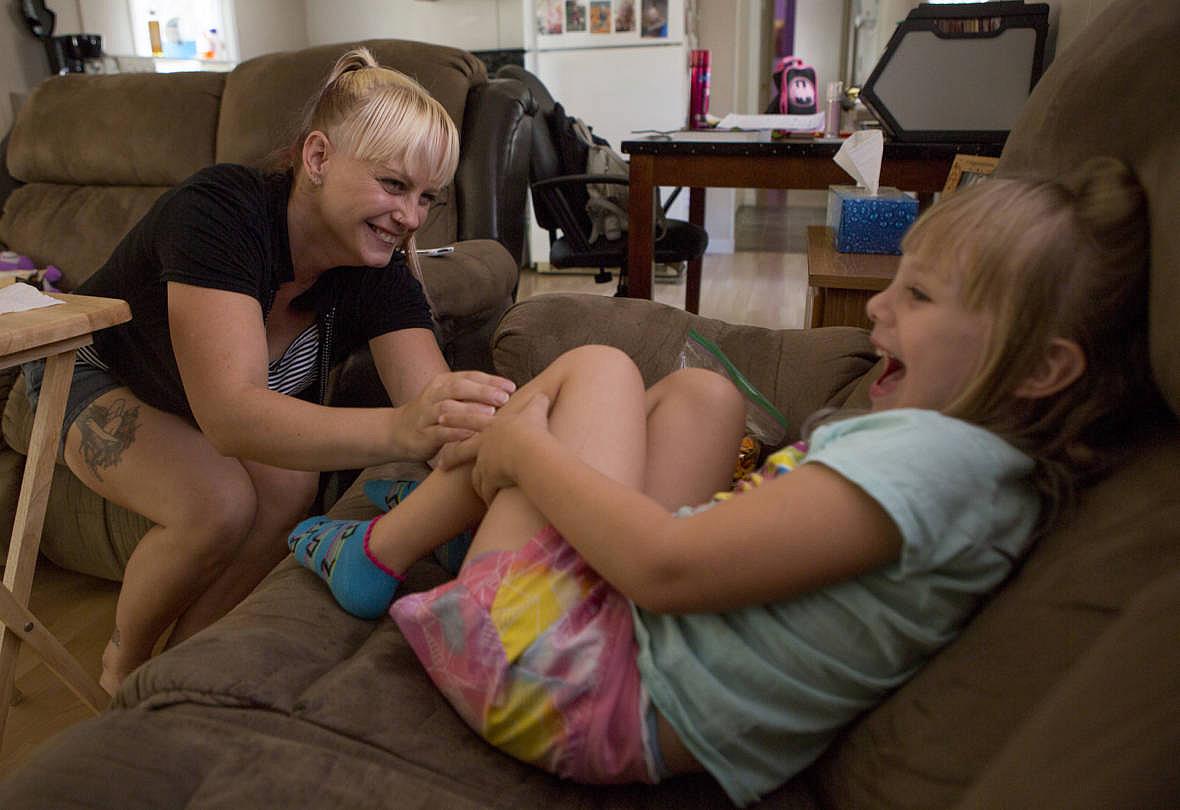Overcoming Childhood Trauma: How Parents and Schools Work to Stop the Cycle
This story was produced as a project for the USC Center for Health Journalism’s California Fellowship.
Other stories in this series include:
Childhood Trauma Can Mean Early Death. This California Mom Wants to Beat the Odds
Paradise remembered by those who called it home
Overcoming a Lifetime of Trauma, Then Facing a New One: Wildfire

After a very difficult upbringing and early adulthood, Sabrina Hanes is doing everything she can to overcome the trauma she experienced and give her daughter, Aroara, the best possible life.
(Photo: Anne Wernikoff/KQED)
Many people have experienced some kind of trauma in their childhood, such as loss of a caregiver, substance abuse in the home, homelessness or abuse. There are ten types of “Adverse Childhood Experiences” that were identified in a study conducted in the 1990s. The total number of childhood traumas someone has experienced determines their ACE score. About 2/3s of the people in the groundbreaking study had at least one ACE, but the researchers also found higher rates of adult physical and mental illness associated with the amount of trauma people experienced as children.
But the impact of trauma can be tempered with interventions, including ones that focus on building and repairing relationships with adults.
Residents of Butte County, California, have some of the highest ACE scores in the state. Public health and social services employees aren’t sure why this is, but cite poverty due to a lack of jobs, and high rates of methamphetamine addiction in the 1990s. The county’s office of education took extraordinary steps to address kids’ needs by taking a trauma-informed approach to educating students.
“Children have to be healthy enough to learn,” said child psychiatrist and Stanford professor Shashank Joshi. “That's something that all school districts can agree on. And mental health is part of overall health.”
At Honey Run Academy in Paradise, California, principal Dena Kapsalis and her staff are careful not to assume anything about their students -- what kinds of homes they come from, or even that they have homes.
If it is the case that a student is homeless, which Kapsalis said is common, she and her staff consider this when acknowledging a student. “We know that there's nobody getting you up in the morning. We know that you're on your own and yet you're here,” said Kapsalis. “It's five minutes before the school starts. That tells us that you want to be a student today that tells us you want to be successful today.”
The school’s environment is built from the idea that each student is an individual and that every interaction is significant. Even a student’s added selection of fruit with a meal is recognized. Multiply those moments over the course of a day, a week, a month and you start to see children growing healthy enough to learn.
TRAUMA AND PARENTS
As a parent, Sabrina Hanes, 33, is conscientious of the experiences she wants to pass on to her daughter, Aroara. She experienced a lot of pain, violence and neglect growing up.
“I have a score of 8 and that’s huge,” said Hanes, referring to her Adverse Childhood Experiences score. “But here I am still, I’m doing it. I’m making it work.”
When she first learned she was pregnant, a doctor recommended she seek services from Youth for Change, a nonprofit in Paradise that, among other things, helps kids and adults who’ve had serious childhood trauma. For years, she took advantage of their parenting classes and child development offerings. These days, she and her daughter participate in Parent-Child Interaction Therapy.
This type of therapy, which focuses on improving communicationbetween parent and child, has been proven to help with behaviors like tantrums and aggression in kids.
Hear how staff and teachers work with kids who’ve experienced serious trauma, and how Sabrina and Aroara heal together on the latest episode of the MindShift Podcast. Listen on Apple Podcasts, Google Play, NPR One or wherever you get your podcasts.
[This story was originally published by KQED News.]
